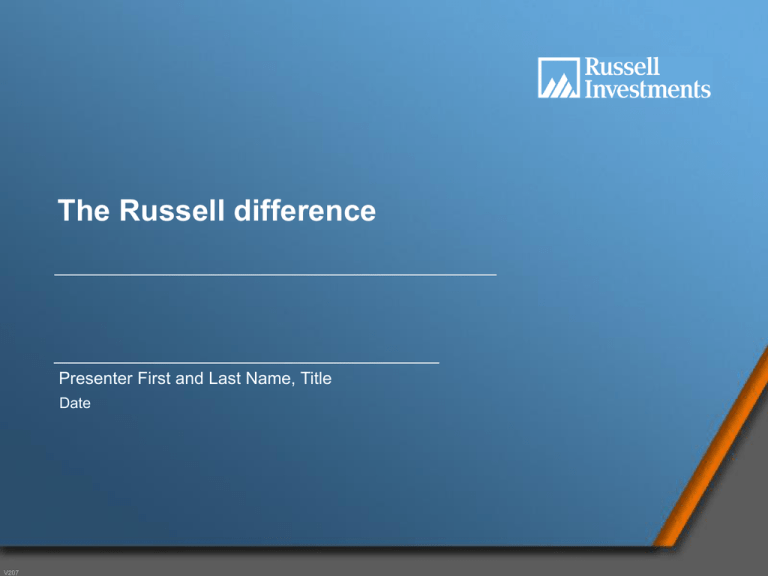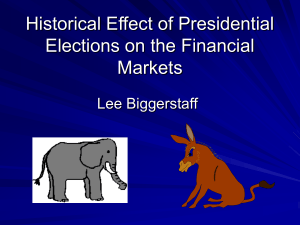
The Russell difference
Presenter First and Last Name, Title
Date
V207
Important Information and Disclosures
Fund objectives, risks, charges and expenses should
be carefully considered before investing. A prospectus
containing this and other important information can be
obtained by calling 800-787-7354 or by visiting
www.Russell.com. Please read the prospectus
carefully before investing.
Client List: U.S. and non-U.S. clients on this representative list were selected from Russell Investment Group’s complete client roster from those
who have given permission to publish their names (as of 2/07). U.S. publicly-held companies listed are Russell clients that appear on the 2007
Fortune 100 list. The non-public company client and endowment/foundation client are each those with the highest total assets. Non-U.S. clients
listed represent those with the highest total assets in each of the following regions: Austral-Asia, Japan and Europe. Performance-based data
was not used in selecting listed clients.
The identification of the clients listed does not constitute an endorsement or recommendation of Russell's products or services by such client.
Copyright© Russell Investments 2008. All rights reserved. This material is proprietary and may not be reproduced, transferred, or distributed in
any form without prior written permission from Russell Investments. It is delivered on an “as is” basis without warranty.
Russell Investment Group is a Washington, USA corporation, which operates through subsidiaries worldwide, including Russell Investments,
and is a subsidiary of The Northwestern Mutual Life Insurance Company.
Securities products and services offered through Russell Financial Services, Inc., member FINRA, part of Russell Investments.
First Used: September 2008
2
V207
Last Updated: February, 2010
RFD 08-0510
Russell Investments
Tacoma 1936
New York 1969
Toronto 1984
London 1979
Paris 1994
According to Cerulli Associates’ 2008 report,
Russell remains the largest global manager-of-managers.
Sydney 1986
Auckland 1991
Singapore 1999
Tokyo 1986
Russell Investments holds the largest market share of the global manager of managers market which includes “collective investment funds or institutional separate accounts with assets
managed as segregated accounts by multiple underlying managers.” The Cerulli Report™, Cerulli Quantitative Update: Global Multimanager Products 2008.
3
V308
Russell investment group
Our purpose: Improving financial security for people
INVESTMENT RESEARCH
Investment
Management
Investment
Consulting
Implementation
Management
Multi-Manager
Funds
Manager Selection
and Investment
Strategy
Brokerage
Services
More than
U.S. $176
billion* under
management
*Assets under management as of 12/31/09.
V308
Transitioned
over $735
billion in
assets in 2008
Advising clients worldwide
Representative Client List
Alcoa
AT&T, Inc.
Barclays Bank
BHP Billiton
Bill and Melinda Gates
Foundation Trust
Build investment strategies
Boeing
CHS, Inc.
Implement disciplined approach
Caterpillar
Coca-Cola Bottling Co.
Mitsui Chemical Co., Ltd.
Public School & Educational
Employee Retirement Systems
of Missouri
Help meet financial goals and obligations
Wilfrid Laurier University
Representative client list as of 02/2010. Clients may contract for a variety of services from Russell Investment Group.
For more information on the selection criteria, please refer to the disclosure slide.
5
V308
Russell Representative Client List
Russell Investment Management
Russell Investment Management
Russell Implementation Services
Agfirst Farm Credit Bank/Agfirst Farm Credit District Employees
Alaska Airlines, Inc.
Alaska Teamster
Arkema Inc.
Associated Benefits Corporation
Baker & McKenzie
Banta Corporation
Basell USA Inc.
Becton, Dickson & Company
Brown-Forman Corporation
Citgo Petroleum Corporation
Computer Sciences Corporation
Continental Tire North America
Convergys Corporation
Cooper Tire & Rubber Company
Cooperative Pension Board
Cultural Institutions Retirement System
Flowserve Corporation
Footlocker, Inc.
Foster Wheeler Inc.
Foundation Coal Corporation
Frank Russell Company
International Truck and Engine Corporation
J.R. Simplot
Jefferson Health System
Louisiana Sheriffs’ Pension and Relief Fund
Marguerite Casey Foundation
Mercedes-Benz USA, LLC
Nestle USA, Inc.
New York Botanical Garden
Newell Rubbermaid Inc.
Nicor, Inc.
Occidental Petroleum Corporation
Office of Hawaiian Affairs
Printpack, Inc.
Reckitt Benckiser Inc.
Rexam, Inc.
Rutland Regional Medical Center
Southern California Edison Company
Southern States Cooperative, Inc.
Square D Company
The East Bay Community Foundation
Thomas Jefferson University
United Airlines
United Farm Family Life Insurance Company
University Medical Associates
Utica Mutual Insurance Group
Virtua Health
Wenatchee Valley Medical Center, P.S.
Bank of Botswana
Bank of Montreal
BOC
Cable & Wireless
Caterpillar Inc.
Civil Aviation Authority Pension Scheme
Dow Chemical Canada, Inc.
Exel
Funds SA
General Motors
Goodyear Tire & Rubber Company
Health Super Pty. Ltd.
IBM Canada
IBM Corporation
J.C. Penney Company, Inc.
MetaaInijverheid
Monsanto Company
Nestle
P&O
PG&E Corporation
Petro-Canada
Post Office
Railpen
Rolls-Royce
Shell Oil Company
Shropshire County Council
Southern California Edison Co.
State of Oregon
United Airlines
Washington State Investment Board
Woolworths Superannuation Board
Russell Consulting
Alcoa
AT&T
Baptist Foundation of Texas
The Bill and Melinda Gates Foundation Trust
Boeing
Campbell Soup
Caterpillar
CBS
Chrysler LLC
Duke Energy
Dun & Bradstreet
EIM
Hearst Foundation
J.C. Penney
Kaiser Permanente
KeySpan
NEIL
Nestle
Ohio STRS
OIL
Missouri PSRS/NTRS
PG&E Corporation
Reynolds American Inc.
Rohm and Haas
Sandia
Shell Oil Company
Southern California Edison
Tomkins
TXU Corporation
Unilever
Unisys
Russell Alternative Investments
British Air
Caparo
Delta Air Lines
Hermes
Industrienz
KeySpan
Washington State Investment Board
Representative Criteria: Investment Management clients with Assets Under Management greater than $150 Million at March 31, 2008. Client is neither terminating nor an account in jeopardy. US Institutional
representative clients were selected based on the specified criteria and includes all those who meet the criteria and have given permission to publish their names as of 3/2008. The identification of the clients
listed does not constitute an endorsement or recommendation of Russell’s products or services by such client. Clients may contract for a variety of services from Russell Investments.
V308
Investment management process
7
V207
What is the challenge?
Increased Return
Achieving Increased Returns Without Increasing Risk
Reduced Risk
8
V207
Investment management discipline
3 fundamental beliefs
Diversifying among asset classes
reduces asset-specific risk
Investment styles move in and out of favor with the
market
Even the best investment managers do not stay on
top for extended periods of time
9
V207
The importance of asset allocation
10
V207
The goal of our investment process
Russell’s goal is to deliver above-average returns
with above-average consistency
Multi-asset:
Up to 4 asset categories
Multi-style:
Multi-manager:
22 potential
investment styles
More than 40 independent
money managers
The Heart of Russell’s difference:
Institutional-quality money managers that are often not available to retail mutual fund investors
V207
Building a stronger portfolio
with multiple asset classes
Asset classes move in and out of favor with the
market in unpredictable ways
Russell offers diversified portfolios that include
holdings in a number of different asset classes
Investors get the benefits of each asset class while
helping to manage risk
12
V207
The importance of asset allocation
Comparing single-asset vs. multi-asset portfolios
V207
The importance of asset allocation
Comparing single-asset vs. multi-asset portfolios
V207
Asset classes
Large Cap – Large capitalization (large cap) investments involve stocks of companies generally having a market capitalization between $10
billion and $200 billion. The value of securities will rise and fall in response to the activities of the company that issued them, general market
conditions and/or economic conditions.
Small Cap – Small capitalization (small cap) investments involve stocks of companies with smaller levels of market capitalization (generally
less than $2 billion) than larger company stocks (large cap). Small cap investments are subject to considerable price fluctuations and are
more volatile than large company stocks. Investors should consider the additional risks involved in small cap investments.
Value – Value investments focus on stocks of income-producing companies whose price is low relative to one or more valuation factors,
such as earnings or book value. Such investments are subject to risks that their intrinsic values may never be realized by the market, or,
such stock may turn out not to have been undervalued. Investors should carefully consider the additional risks involved in value investments.
Growth – Growth investments focus on stocks of companies whose earnings/profitability are accelerating in the short term or have grown
consistently over the long term. Such investments may provide minimal dividends which could otherwise cushion stock prices in a market
decline. Stock value may rise and fall significantly based, in part, on investors’ perceptions of the company, rather than on fundamental
analysis of the stocks. Investors should carefully consider the additional risks involved in growth investments.
Real Estate – Specific sector investing such as real estate can be subject to different and greater risks than more diversified investments.
Declines in the value of real estate, economic conditions, property taxes, tax laws and interest rates all present potential risks to real estate
investments. Fund investments in non-U.S. markets can involve risks of currency fluctuation, political and economic instability, different
accounting standards and foreign taxation.
Non-US – Non-US markets entail different risks than those typically associated with US markets, including currency fluctuations, political and
economic instability, accounting changes, and foreign taxation. Securities may be less liquid and more volatile.
Bonds – Bond investors should carefully consider risks such as interest rate, credit, repurchase and reverse repurchase transaction risks.
Greater risk, such as increased volatility, limited liquidity, prepayment, non-payment and increased default risk, is inherent in portfolios that
invest in high yield ("junk") bonds or mortgage backed securities, especially mortgage backed securities with exposure to sub-prime
mortgages.
Although stocks have historically outperformed bonds, they also have historically been more volatile. Investors should carefully consider their
ability to invest during volatile periods in the market.
15
V207
Important information for previous slide
Performance quoted represents past performance and does not guarantee future results.
Indexes and/or benchmarks are unmanaged and cannot be invested in directly. Returns represent past performance, are not a guarantee of
future performance, and are not indicative of any specific investment. All investments are subject to market risks and a potential loss of
principal. The investment return and principal value will fluctuate, and when sold, may be worth more or less than their original cost, and
could result in a taxable event.
Individual asset classes represented by the following indices: large cap = S&P 500; small cap = Ibbotson & Associates, 1972–1978, Russell
2000®, 1979–2007; bonds = S&P High Grade Corporate Bond Index, 1972-1973, Lehman Brothers Aggregate Bond™ Index, 1974-2007;
international = MSCI® EAFE; real estate = NAREIT Equity Index. Asset allocated mixes employ the same indices listed above and are
rebalanced annually. They are represented by the following asset class breakdowns:
100% stock = 60% large cap, 10% small cap, 5% real estate, 25% international;
80% stock/20% bond = 42% large cap, 11% small cap, 5% real estate, 24% international, 18% bonds;
60% stock/40% bond = 32% large cap, 5% small cap, 17% international, 5% real estate, 41% bonds;
40% stock/60% bond = 22% large cap, 3% small cap, 12% international, 3% real estate, 59% bonds;
20% stock/80% bond = 9% large cap, 2% small cap, 5% international, 1% real estate, 82% bonds.
Standard deviation is a statistical measure of the degree to which an individual value in a probability distribution tends to vary from the mean
of the distribution. The greater the degree of dispersion, the greater the risk.
16
V207
The value of diversification by style
17
V207
Gaining advantages using multiple styles
Investment styles continually move in and out of
favor with the market
The cycles are hard to predict because they don’t
rotate with any pattern
Russell believes that the superior strategy is to
combine managers with different styles in
complementary ways
18
V207
What pattern do you see?
Long-term lesson: Styles rise…and fall…randomly (1 of 2)
TOP PERFORMING STYLES 1980–2009* in a US Equity Portfolio
30
1998
LARGE
25
20
1990
1989
15
1984
1986
1987
1997
10
1995
2007
1996
5
0
5
2005
VALUE
2009
1985
GROWTH
1994
2002
2006
1981
2000
1982
1980
2004
1993
10
1999
2008
1988
1991
1983
2001
15
1992
2003
20
1979
25
SMALL
30
30
25
20
15
10
5
0
5
10
15
20
25
30
*SOURCE: % performance differences for Russell 1000® Growth vs. Russell 1000® Value and Russell 1000® vs Russell 2000® Indexes. Index performance is not indicative of the
performance of any specific investment. Indexes are not managed and may not be invested in directly. Past performance is not a guarantee of future results.
19
V207
Important information for preceding chart
(Slide 2 of 2)
Russell 1000® Index: measures the performance of the 1,000 largest companies in the Russell 3000® Index, representative of the US large
capitalization securities market.
Russell 1000® Growth Index: measures the performance of those Russell 1000® Index securities with higher price-to-book ratios and higher
forecasted growth values, representative of US securities exhibiting growth characteristics.
Russell 1000® Value Index: measures the performance of those Russell 1000® Index securities with lower price-to-book ratios and lower
forecasted growth values, representative of US securities exhibiting value characteristics.
Russell 2000® Index: measures the performance of the 2,000 smallest companies in the Russell 3000® Index, representative of the US small
capitalization securities market.
Index performance is not indicative of the performance of any specific investment. Indexes are not managed and may not be invested in directly.
Diversification and strategic asset allocation do not assure profit or protect against loss in declining markets.
Large capitalization (large cap) investments involve stocks of companies generally having a market capitalization between $10 billion and $200
billion. The value of securities will rise and fall in response to the activities of the company that issued them, general market conditions and/or
economic conditions.
Small capitalization (small cap) investments involve stocks of companies with smaller levels of market capitalization (generally less than $2
billion) than larger company stocks (large cap). Small cap investments are subject to considerable price fluctuations and are more volatile than
large company stocks. Investors should consider the additional risks involved in small cap investments.
Value investments focus on stocks of income-producing companies whose price is low relative to one or more valuation factors, such as
earnings or book value. Such investments are subject to risks that their intrinsic values may never be realized by the market, or, such stock
may turn out not to have been undervalued. Investors should carefully consider the additional risks involved in value investments.
Growth investments focus on stocks of companies whose earnings/profitability are accelerating in the short term or have grown consistently
over the long term. Such investments may provide minimal dividends which could otherwise cushion stock prices in a market decline. Stock
value may rise and fall significantly base, in part, on investors' perceptions of the company, rather than on fundamental analysis of the stocks.
Investors should carefully consider the additional risks involved in growth investments.
20
V207
Finding top investment management
V207
Value of diversification 1993-2009
(1 of 2)
1994
1995
1996
INT’L
LARGE CAP
VALUE
REAL
ESTATE
8.06
REAL
ESTATE
3.17
38.35
LARGE CAP
37.77
35.26
1997
0.38
35.18
-1.82
LARGE CAP
VALUE
-1.99
SMALL CAP
GROWTH
38.71
43.09
2000
2001
2002
2003
2004
REAL
ESTATE
SMALL CAP
VALUE
BONDS
SMALL CAP
GROWTH
REAL
ESTATE
26.35
LARGE CAP
LARGE CAP SMALL CAP
LARGE CAP LARGE CAP
GROWTH
GROWTH
VALUE
32.85
27.02
23.12
33.16
22.83
14.03
10.26
REAL
ESTATE
REAL
ESTATE
13.93
3.81
INT’L
INT’L
BONDS
BONDS
20.33
27.30
11.63
8.44
-11.43
SMALL CAP
SMALL CAP
VALUE
16.49
25.75
BONDS
18.47
REAL
ESTATE
REAL
ESTATE
20.29
BONDS
8.69
BONDS
6.36
9.65
-2.43
15.25
BONDS
INT’L
BONDS
INT’L
-2.92
11.55
3.63
2.06
20.91
-3.02
LARGE CAP
VALUE
-5.59
INT’L
-15.66
2006
2007
2008
2009
INT’L
REAL
ESTATE
LARGE CAP
GROWTH
BONDS
LARGE CAP
GROWTH
14.02
31.57
SMALL CAP
SMALL CAP
VALUE
REAL
ESTATE
22.25
12.15
47.25
46.03
INT’L
39.17
REAL
ESTATE
37.14
INT’L
20.70
11.81
INT’L
INT’L
26.86
11.63
BONDS
INT’L
-0.82
-13.96
5.24
6.27
LARGE CAP
VALUE
22.25
BONDS
6.97
37.21
-28.92
34.47
INT’L
32.46
LARGE CAP
LARGE CAP
VALUE
28.43
-36.85
LARGE CAP LARGE CAP
SMALL CAP LARGE CAP LARGE CAP
GROWTH
VALUE
5.77
18.37
-37.60
5.26
16.49
REAL
ESTATE
-37.73
REAL
ESTATE
27.99
SMALL CAP
27.17
LARGE CAP SMALL CAP
LARGE CAP LARGE CAP LARGE CAP LARGE CAP SMALL CAP SMALL CAP SMALL CAP
VALUE
GROWTH
GROWTH
-21.65
29.89
4.55
-12.45
11.40
-1.57
13.35
20.58
-38.44
SMALL CAP SMALL CAP LARGE CAP LARGE CAP LARGE CAP LARGE CAP LARGE CAP SMALL CAP LARGE CAP SMALL CAP SMALL CAP LARGE CAP
VALUE
VALUE
VALUE
GROWTH
GROWTH
GROWTH
GROWTH
GROWTH
GROWTH
GROWTH
GROWTH
VALUE
-6.45
-1.49
-22.42
-20.42
-27.89
29.75
6.30
4.15
9.07
-9.78
REAL
ESTATE
REAL
ESTATE
SMALL CAP
GROWTH
INT’L
SMALL CAP
GROWTH
BONDS
BONDS
BONDS
BONDS
REAL
ESTATE
4.10
4.34
2.43
4.33
-17.51
-4.62
-22.43
-21.21
-30.26
-15.69
-38.54
19.69
INT’L
BONDS
-43.06
5.93
Please note that this chart is based on past index performance and is not indicative of future results. Indexes are unmanaged and cannot be invested in directly.
Index performance does not include fees and expenses an investor would normally incur when investing in a mutual fund. Diversification and strategic asset allocation
do not assure profit or protect against loss in declining markets.
V207
BEST
PERFORMANCE
SMALL CAP SMALL CAP
GROWTH
VALUE
LARGE CAP SMALL CAP SMALL CAP
SMALL CAP
VALUE
VALUE
GROWTH
-33.79
7.05
23.48
7.05
SMALL CAP LARGE CAP
18.33
35.06
LARGE CAP SMALL CAP SMALL CAP
SMALL CAP
SMALL CAP LARGE CAP
LARGE CAP
LARGE CAP
SMALL CAP
LARGE CAP
VALUE
VALUE
GROWTH
GROWTH
GROWTH
VALUE
VALUE
-7.79
-20.49
15.46
7.35
30.03
-9.23
14.31
1.23
-0.17
4.71
SMALL CAP SMALL CAP
SMALL CAP
GROWTH
GROWTH
-2.55
11.26
12.95
INT’L
LARGE CAP SMALL CAP
2005
48.54
SMALL CAP SMALL CAP
VALUE
VALUE
LARGE CAP
LARGE CAP
SMALL CAP LARGE CAP LARGE CAP LARGE CAP
SMALL CAP
SMALL CAP
VALUE
GROWTH
VALUE
VALUE
GROWTH
VALUE
21.26
2.49
21.64
30.49
7.01
-15.52
31.04
15.63
SMALL CAP
SMALL CAP
SMALL CAP
SMALL CAP
VALUE
VALUE
22.36
28.44
-1.55
21.37
SMALL CAP
1999
LARGE CAP LARGE CAP SMALL CAP
VALUE
GROWTH
GROWTH
LARGE CAP LARGE CAP
SMALL CAP
LARGE CAP
GROWTH
VALUE
GROWTH
22.45
2.66
31.78
37.19
LARGE CAP
1998
WEAKEST
PERFORMANCE
Value of diversification 1993-2009
(2 of 2)
SOURCES:
Large Cap
Russell 1000® Index
Measures the
performance of the 1,000
largest companies in the
Russell 3000® Index,
representative of the US
large capitalization
securities market.
Small Cap Value
Russell 2000®
Value Index
Measures the
performance of those
Russell 2000® Index
securities with lower
price-to-book ratios and
lower forecasted growth
values, representative of
US securities exhibiting
value characteristics.
V207
Large Cap Growth
Russell 1000® Index
Measures the
performance of those
Russell 1000® Index
securities with higher
price-to-book ratios and
higher forecasted growth
values, representative of
US securities exhibiting
growth characteristics.
Large Cap Value
Russell 1000®
Value Index
Measures the
performance of those
Russell 1000® Index
securities with lower
price-to-book ratios and
lower forecasted growth
values, representative of
US securities exhibiting
value characteristics.
International
MSCI® EAFE Index
Real Estate
NARIET Equity
Reit Index
An index, with dividends
reinvested, representative
of the securities markets
of twenty developed
market countries in
Europe, Australasia, and
the Far East.
An index, with dividends
reinvested, representative
of tax-qualified REITS
listed on the New York
Stock Exchange,
American Stock
Exchange, and the
NASDAQ National Market
System.
Small Cap
Russell 2000® Index
Measures the
performance of the 2,000
smallest companies in the
Russell 3000® Index,
representative of the US
small capitalization
securities market.
Bonds
Barclays Capital U.S.
Aggregate Bond Index
An index, with income
reinvested, generally
representative of
intermediate-term
government bonds,
investment-grade
corporate debt securities,
and mortgage-backed
securities.
Small Cap Growth
Russell 2000®
Growth Index
Measures the
performance of those
Russell 2000® Index
securities with higher
price-to-book ratios and
higher forecasted growth
values, representative of
US securities exhibiting
growth characteristics.
Illustrating common pitfalls
Few Managers Stay in the Top Quartile Consecutively
Six Years 2004–2009
39
Of the top 39
performing
managers in
2004*, no one
manager stayed
on top over time
20
7
2004
2005
2006
0
0
0
2007
2008
2009
*U.S. equity managers source: Russell Universe of 155 equity manager products with six years of return history ending December 31, 2009.
24
V207
The investor’s predicament…
What Investment Managers Rarely Volunteer
Who has REALLY been responsible for their record… and when!
The person responsible for their performance
has departed
Key people are planning to leave, retire or are
being reassigned
The new Portfolio Manager has a different investment philosophy
from his/her predecessor
Their investment process has changed
The manager’s “motivation” has changed
Too easy to mistake “luck” for “skill”
25
V207
Russell’s global team of investment experts
Russell investment process
Trading &
Implementation
70
252
Manager Research &
Portfolio Management
Current as of 6/30/09
26
V207
Russell puts more than 650
investment professionals from
around the world to work for you
Review & Control
110
225
Asset Allocation &
Capital Markets Research
Russell Investments
Our manager research approach…
Healthy skepticism
Manager must show added value
Multiple participants
Our analysts monitor over 8,000 investment products & over
1,800 investment firms in more than 20 countries*
Multiple evaluation points
Managers examined in a variety of contexts over time
Multiple, face-to-face, on-site meetings
5,200+ in-depth research meetings annually*
*As of 6/30/09
V207
Russell manager research and
implementation expertise
Asset allocation & capital
markets research
Understanding the
active management
opportunity
200+ professionals
7 years average
Russell tenure
24 PhDs
Asset class risks
Return opportunities
Manager research
Our information
advantage
100+ analysts
4 years average Russell
tenure
5,200+ meetings*
Analyst specialization
Independence and
objectivity
Excess return forecasts
Stability forecasts
Buy/hold/sell rankings
Portfolio management
Strategically
combining active
managers
~100 portfolio strategy
professionals
70 trading/
implementation
professionals
100+ review/ control/
senior management
professionals
Access
Innovation
Implementation
Designed for consistency
of performance
As of June, 2009
Source: Russell Corporate Marketing Vital Statistics and Human Resources
* Meetings include face-to-face as well as teleconference/video-conference meetings (also includes multiple meetings with the same investment management firm).
28
V308
The Russell difference
Qualitative and quantitative methodology
People Factors
Process Factors
Leadership
Quality of Personnel
Continuity of Team
Competitive Drive
Strength of Philosophy
Technological Superiority
Implementation Skill
Risk-management Techniques
Qualitative 75%
Alpha Potential
Organizational Stability
Alpha Potential
Reliability of Alpha
Evaluation
Portfolio Consistency
vs.
Expectations
Getting Paid
for the Risk?
Quantitative 25%
29
V207
Portfolio Structure
Performance Characteristics
Validation of Style
Adherence to Philosophy
Role in Funds
Scenario Risks
Excess Returns vs. Indexes
Peer Group Comparisons
Information Ratios
Source of Excess Returns
The Russell difference
Qualitative and quantitative methodology
Qualitative 75%
People Factors
Process Factors
Leadership
Quality of Personnel
Continuity of Team
Competitive Drive
Strength of Philosophy
Technological Superiority
Implementation Skill
Risk-management Techniques
Expectations
Validation
Quantitative 25%
30
V207
Portfolio Structure
Performance Characteristics
Validation of Style
Adherence to Philosophy
Role in Funds
Scenario Risks
Excess Returns vs. Indexes
Peer Group Comparisons
Information Ratios
Source of Excess Returns
Confirmation
Russell’s manager selection process
8,200
5,000
590
Total manager products monitored by Russell
Investment products continually
monitored and researched
Manager products with a primary ‘hire’ rating
196
Russell investment manager products
Data as of 12/31/09
31
V207
Russell funds
Russell U.S.
Quantitative
Equity Fund
Russell TaxManaged
Large Cap Fund
Russell U.S.
Value Fund
Russell U.S.
Growth Fund
6 Manager Products
5 Manager Products
4 Manager Products
9 Manager Products
Russell TaxManaged
Mid & Small Cap
Fund
Russell Global
Equity Fund
Russell
International
Developed
Markets Fund
Russell
Emerging
Markets Fund
5 Manager Products
5 Manager Products
9 Manager Products
6 Manager Products
Russell Strategic
Bond Fund
Russell Short
Duration
Bond Fund
Russell Tax
Exempt
Bond Fund
Russell Real
Estate
Securities Fund
Russell Money
Market Fund
5 Manager Products
2 Manager Products
2 Manager Products
5 Manager Products
1 Manager Product
Russell U.S. Core
Equity Fund
11 Manager
Products
Russell U.S.
Small & Mid Cap
Fund
8 Manager Products
As of 12/31/09. Not all funds and share classes are available through all distribution partners
V207
Five strategically diversified portfolios
Model Strategies represent target allocations of Russell funds;
these models are not managed and cannot be invested in directly.
HIGHER
Equity Growth
POTENTIAL RETURN
Growth
Balanced
Moderate
80%
20%
100%
0%
60%
40%
Conservative
40%
60%
Stocks
Bonds
20%
80%
LOWER
RISK
HIGHER
As you move from left to right on the graph—increasing risk—there are different model strategies that can offer higher return potential. However, as
with any type of portfolio structuring, attempting to reduce risk and increase return could, at certain times, unintentionally reduce returns.
V207
Russell sample portfolio
Balanced model strategy for Russell funds
4 asset categories
30% U.S. Equity
5% Real Estate
40% Fixed
Income
Russell Real Estate Securities 5%
Russell Strategic
Bond 40%
25% International and Global Equity
8 Russell Funds
Russell U.S. Core Equity
13%
Russell
U.S.
Quant Eq
13%
Russell U.S. Small &
Mid Cap 4%
Russell Global Equity
8%
Russell International
Developed Markets 14%
Russell Emerging Markets
3%
22 investment styles
Growth
MarketOriented
Value
MarketOriented
Growth
MarketOriented
Value
Growth
MarketOriented
Value
Growth
MarketOriented
Value
Growth
MarketOriented
Clarivest
Delphi
Gartmore
MFS
Harris
Associates
Axiom
AQR
Capital
Alliance
Bernstein
T. Rowe
Price
Arrowstreet
Capital
T. Rowe
Price
Tradewinds
Marisco
MFS
Mondrian
UBS
Genesis
Global
MarketOriented
Growth
U.S.
MarketOriented
Value
Fully
Discretionary
Alliance Cohen &
Bernstein Steers
Heitman
Cohen &
Steers
AEW
Goldman
Brookfield
Sachs
Value
Sector
Rotation
55 manager products
BlackRock
First
Eagle
Alliance
Bernstein
AJO
Next
Century
Growth
Columbus
Circle
Lazard
Institutional
Capital
Goldman
Sachs
Ranger
DePrince,
Race &
Zollo
Montag &
Caldwell
RIMCo†
MFS
INTECH
Tygh
Capital
Jacobs
Levy
UBS
Suffolk
Schneider
Jacobs
Levy
Signia
Capital
William
Blair & Co.
Pzena
Harding
Loevner
INVESCO
PIMCO
Logan
Circle
MetWest
Numeric
Investors
RIMCo†
† This represents the role of the Funds’ investment advisor, Russell Investment Management Company (“RIMCo”), in exercising investment discretion over a portion of the Fund’s
assets RIMCo has determined not to assign to a money manager pursuant to a proprietary “select holdings” investment strategy as more fully described in the Funds’ prospectuses.
This does not represent the other aspects of RIMCo’s role as investment advisor of the Funds.
Model Strategies represent target allocations of Russell funds; these models are not managed and cannot be invested in directly. You and your financial advisor may work to combine
selected funds that differ from the illustrated combinations depending upon individual investment options.
Managers Current as of March 1, 2010
34
V207
FINANCIAL PROFESSIONAL USE ONLY
Russell Sample Portfolio
Money managers listed are current as of 6/15/09. Subject to the Fund’s Board approval, Russell has the right to engage or terminate a money manager at any time and without a
shareholder vote, based on an exemptive order from the Securities and Exchange Commission. If applicable, please refer to the most recent prospectus which will contain the
latest information.
The Funds' adviser may employ a “select holdings” strategy for a portion of the Fund’s assets that it determines not to allocate to the money managers. The strategy is designed
to increase the Fund's exposure to stocks that are viewed as attractive by multiple money managers. The use of the select holdings strategy will amplify the funds security risk
and potential underperformance.
Investments in emerging or developing markets involve exposure to economic structures that are generally less diverse and mature, and to political systems which can be
expected to have less stability than those of more developed countries. Securities may be less liquid and more volatile than U.S. and longer-established non-U.S. markets. If
applicable, please see the Prospectus for further detail.
Non-U.S. markets entail different risks than those typically associated with U.S. markets, including currency fluctuations, political and economic instability, accounting changes,
and foreign taxation. Securities may be less liquid and more volatile. If applicable, please see a prospectus for further detail.
Specific sector investing such as real estate can be subject to different and greater risks than more diversified investments. Declines in the value of real estate, economic
conditions, property taxes, tax laws and interest rates all present potential risks to real estate investments. Fund investments in non-U.S. markets can involve risks of currency
fluctuation, political and economic instability, different accounting standards and foreign taxation.
Bond investors should carefully consider risks such as interest rate, credit, repurchase and reverse repurchase transaction risks. Greater risk, such as increased volatility, limited
liquidity, prepayment, non-payment and increased default risk, is inherent in portfolios that invest in high yield ("junk") bonds or mortgage backed securities, especially mortgage
backed securities with exposure to sub-prime mortgages.
Stock/Equity investors should carefully consider risks such as market risk when investing. There are no guarantees when it comes to individual stocks. Any stock may go
bankrupt, in which case your investment may be worth nothing.
Global equity involves risk associated with investments primarily in equity securities of companies located around the world, including the United States. International securities
can involve risks relating to political and economic instability or regulatory conditions. Investments in emerging or developing markets involve exposure to economic structures
that are generally less diverse and mature, and to political systems which have less stability than those of more developed countries.
Model Strategies are exposed to the specific risks of the funds directly proportionate to their fund allocation. The funds comprising the strategies and the allocations to those
funds have changed over time and may change in the future.
V207
Making the smart choice
No one asset class is always best
No one style is always best
No one manager is always best
So, a Multi-Asset Multi-Style Multi-Manager
solution makes a lot of sense
36
V207
www.russell.com
V207








